Rennie Scaysbrook | March 9, 2017
The Kawasaki Z900 ABS becomes the king of the Z family
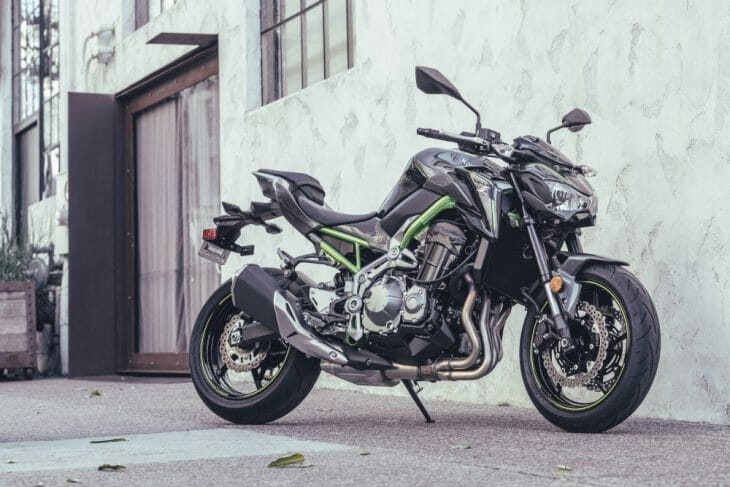 Ground up, the Z900 is all new. Kawasaki’s done good with this one…
Ground up, the Z900 is all new. Kawasaki’s done good with this one…
Now is a pretty good time if you’re into nakedbikes, especially if you like them with a splash of green.
Kawasaki is back in the nakedbike game but they’re not going the superbike-with-high-bars route of KTM, Aprilia and Yamaha. Instead, they’re leaning more towards everyday riders with a greater focus on street performance in the brand new Kawasaki Z900 ABS.
The Z900 is now the headline act in the Z roadshow as the Z1000, Japan’s biggest super-naked at 1043cc that went toe-to-toe with the Aprilia Tuono 1100 and KTM 1290 Super Duke R, is no longer part of Kawasaki USA’s line-up. A tragedy? Maybe. But fans of the big Z needn’t have worried, because Kawasaki’s put everything into this new Z900 so that the only thing you miss about the heavyweight Z1000 is, well, nothing, really.
The Z900 also does away with the overweight and under-appreciated Z800, a bike that was only sold for two years in the U.S. The 800 actually came out in 2012, but we never got a taste of the Kawi naked here until 2015, when the bike was badged a 2016 model.
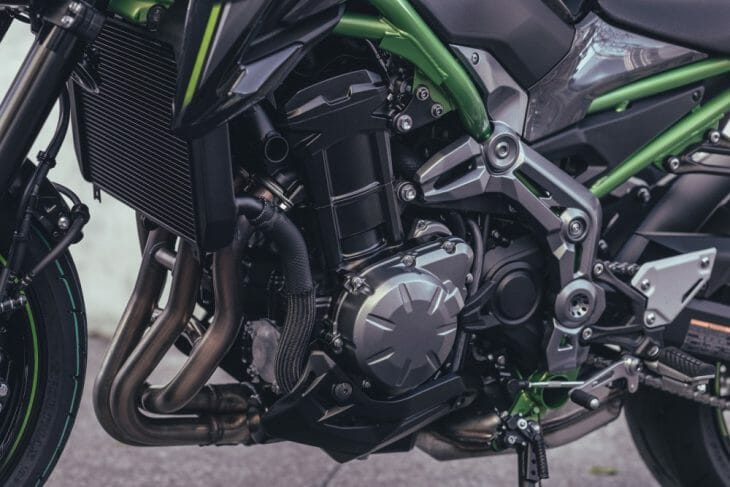 The 948cc motor was developed to give similar performance to the old 1043cc unit but without the weight to push.
The 948cc motor was developed to give similar performance to the old 1043cc unit but without the weight to push.
Last year the Z family became complete as it gave birth to the Z125 Pro, one of our very favorite little fun bikes that looks as cool as it is to ride. That coincided with a rise in the number of riders considering a nakedbike as their choice of motorcycle transportation (we think every rider should own a nakedbike, but that’s just us), so Kawasaki saw it fit to swap the 800 and 1000 for a 900 and put its money where its proverbial mouth was.
More than you bargained for
In true Kawi naked guise, the new 900 is a little over what it says on the packet. Your money will get you 948cc of in-line four-cylinder goodness, matched to a six-speed gearbox, all wrapped in a stunning trellis frame that looks eerily similar to the king of Kawasakis in the H2 and H2R.
The new motor comes with 73.4 x 56mm dimensions for that 948cc, designed to be less rev-happy than the old 800 and less intimidating that the 1000. Kawasaki’s made an emphasis on low-to mid-range torque to make this engine as appealing as possible everyday commuters. The same end game is said for the dual 36mm throttle bodies, a system that was employed on the 1000 with its 38mm throttle bodies but not the slightly jerky 800’s 34mm units, a bike that didn’t have the smoothest throttle response from fully closed.
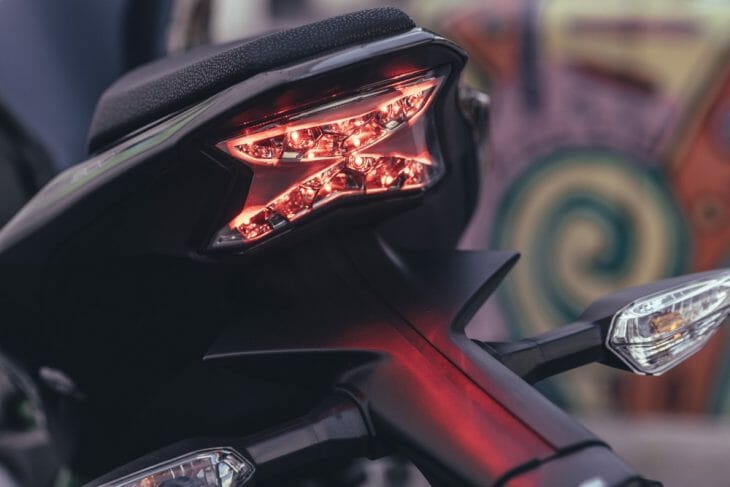 Cool Z pattern taillight is now a fixture of every bike in the Z line up.
Cool Z pattern taillight is now a fixture of every bike in the Z line up.
The intake houses different length funnels (the two outer funnels are shorter than the two center ones), with the airbox specifically tuned to get the best audio note under acceleration. No, really, Kawasaki actually had an acoustics team work with the engineers to ‘develop’ a more pleasing, muscular intake sound than either the old 800 or 1000!
The pistons come from the same machining process as the H2’s; the connecting passageways at the bottom of the cylinders help reduce pumping losses and contribute to better high rpm performance; and the crankshaft has been lightened to enable to the motor to spin up quicker. A secondary balancer driven off a gear on the sixth web of the crank helps to reduce the overall vibration.
There’s no quickshifter for the six speed gearbox, but you do get a slip and assist clutch and what Kawasaki is calling a true overdrive sixth gear for economical highway cruising.
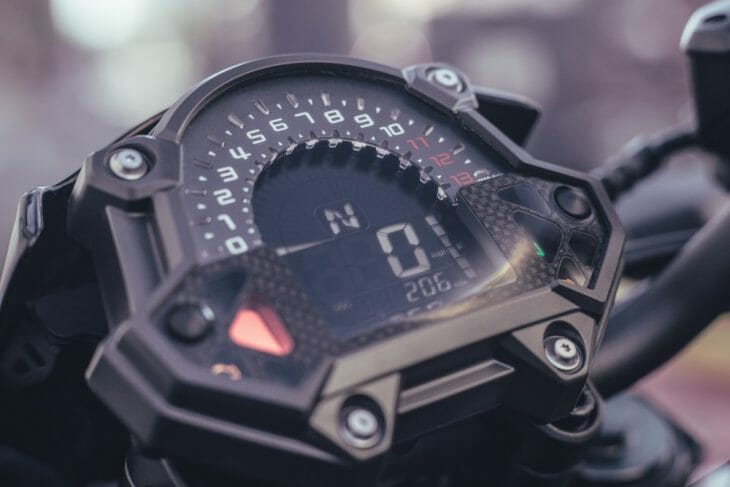 Dash comes in three different configurations and displays speed, fuel level, dual trip meters, current and average fuel consumption, clock and an economical riding indicator.
Dash comes in three different configurations and displays speed, fuel level, dual trip meters, current and average fuel consumption, clock and an economical riding indicator.
On the exhaust side, there’s four new 35mm headers, fed into a smaller catalytic converter and single muffler that’s slightly more aggressive looking than the Z650.
Bones from the H2
The Z900’s chassis is all new, developed from the H2. The steel trellis looks absolutely awesome in Kawasaki’s metallic lime green (it looks pretty plain-Jane in the black color scheme) and weighs only a claimed 30lb with the subframe no longer detachable and the engine mounted as a stressed member. That light weight extends to the swingarm, which weighs a claimed 8lb working a shock that comes with preload and rebound damping adjustment, the same as the 41mm inverted forks up front.
The brakes are dual conventionally-mounted four-piston calipers gripping 300mm discs, with the rear a single-piston caliper working a 250mm discs. Interestingly, the brakes are the only area you’ll find any form of rider aid in the Nissin ABS system that you can’t switch off on the ABS model. Kawasaki has released this bike sans traction control and variable rider modes, a refreshing development considering it would likely save the customer a few bucks and the bike really didn’t need them anyway.
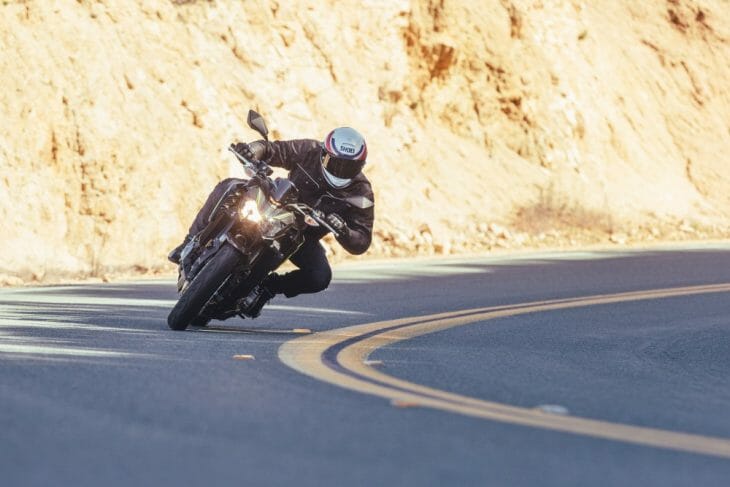 The Z900 is just at home scratching through canyons as it is chasing the city lights.
The Z900 is just at home scratching through canyons as it is chasing the city lights.
The lack of a variable ride mode means you get all the engine, all the time. You’re not artificially held back by some electric bungee cord, which allows you to fully explore this vastly improved powerplant to the fullest.
Ten years ago, the 900 would be considered close to a full size bike. Not anymore with the current crop of 100cc-plus master blasters, but that matters not because Kawasaki got this engine very close to spot on. This on-the-large-side-of-midsize engine has a really surprising level of performance that is not far off what the 1043cc Z1000 had just last year, but with far less weight to shift.
There are two standout points in the engine—the excellent bottom-end torque and the initial throttle response. A couple of times in my ride around San Diego, I pulled away from the stop sign in fourth gear. Normally a four-cylinder of this size would fall flat on its face and stall immediately, but the 948cc lump pulled away superbly smoothly, with hardly a jerk from the fueling or transmission.
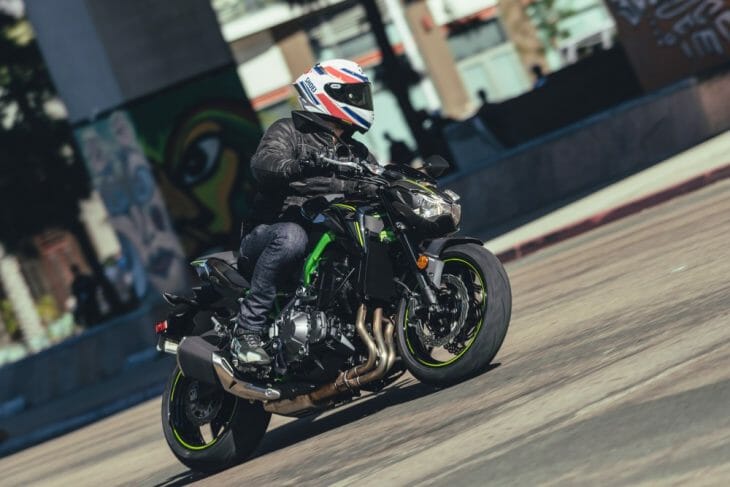 City streets and stop signs show off just how flexible and strong that new motor is. Fourth gear pull aways from the stop signs are easy, although not entirely recommended.
City streets and stop signs show off just how flexible and strong that new motor is. Fourth gear pull aways from the stop signs are easy, although not entirely recommended.
The 900 is a wholly more flexible motor than the outgoing 800; the torque is more evenly spread across the rev range and even though Kawasaki has made the ratios somewhat short (except for sixth gear), I didn’t find myself jumping up and down on the gear lever too much to keep the motor in its happy zone.
Wait for the kick
But the Z900 is still a four-cylinder with roots stemming from its superbike range and as such, you get a wonderful, thunderous push at 6000rpm that’s been manufactured into its persona, much like the aforementioned induction roar which, I’m happy to say, is an absolute aural joy to the sensors. The Z900 can be as sedate as you like in the lower rev ranges, but get it moving hard above 6000rpm and she fair goes for it, lifting the front in the first three gears and generally behaving like a bit of a brat, which I absolutely love.
The Z900 has more personality than either the old 800 or the 1000. It feels like you’re more connected to the experience thanks to the lack of ride modes and traction control and it allows you to ride almost any way you like—flat out with a front wheel waving like Aaron Colton—or sedate, like me, when I’m getting bread on Sunday morning.
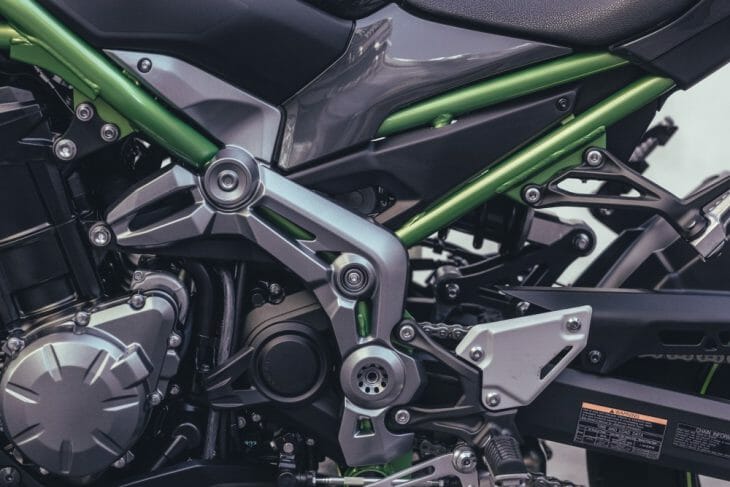 The green steel trellis chassis is the visual standout feature. The photos don’t do it justice.
The green steel trellis chassis is the visual standout feature. The photos don’t do it justice.
It can be either because the lack of girth of this new bike gives it added flexibility, making it equally happy in congested city streets or out in the canyons with buddies. The fit’s pretty snug, but roomier than the overly tight Z1000, so those with longer legs shouldn’t have too many issues fitting on. It’s a pretty low seat height at 31.3 inches, and I did try a Z900 with the aftermarket Ergo Fit seat that’s one inch taller, but I wouldn’t recommend it as my butt went to sleep really quickly as the seat foam construction wasn’t hard enough.
I always liked the fit of the 800 over the 1000 and thankfully the 900 hasn’t changed too much in overall ergonomics. You have plenty of room to muscle the bike through corners and you can push that front end surprisingly hard with the standard Dunlop D214F tires that have been around for quite some time now, and the brakes, even though they are the same calipers Kawasaki has been using for what feels like forever, still work plenty well although a good, hard squeeze at the lever will get the ABS pumping pretty quickly. If you want absolutely no electronics, you can just buy the non ABS model. Or, if you see me in person, I’ll tell you how you can fool Nissin system into switching off without pulling the ABS fuse…
Kawasaki has priced this 900 very competitively at $8399 for the base model and $8799 for the ABS version, putting it right in the ball park against arch rivals Yamaha with the new FZ-09, and a couple of grand less than the Ducati Monster 821 and the base model Triumph Street Triple 765.
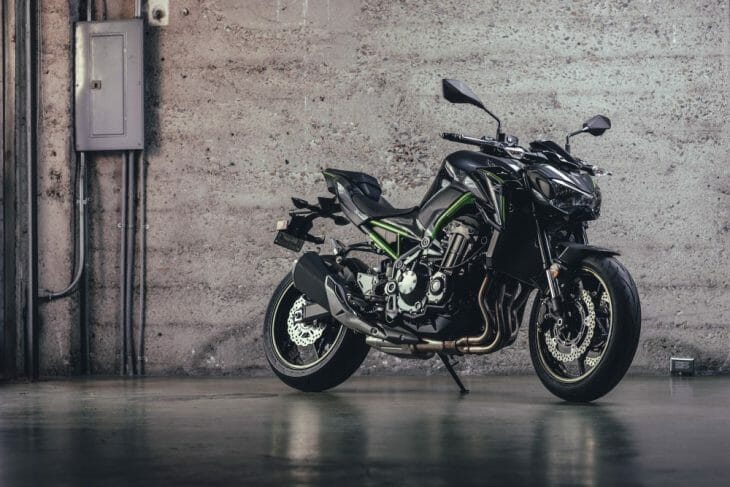 Unlike when the 800 came out in 2015, all 50 U.S. states will be able to buy this bike as soon as they hit dealer floors.
Unlike when the 800 came out in 2015, all 50 U.S. states will be able to buy this bike as soon as they hit dealer floors.
That and the fact the engines on Z model Kawasakis are damn near bulletproof means Kawasaki should sell a boat load of these new 900s. The mid-size nakedbike sector is fast becoming the one to watch as superbikes get techier and more expensive and those who don’t want a scrambler or ADV bike go searching for the perfect city commuter and canyon carver.
Kawasaki’s decision to trade the Z1000 and Z800 for the Z900 is already proving to be the right one.
Specifications
2017 Kawasaki Z900 ABS
Engine: Four-stroke, liquid-cooled, DOHC, four valves per cylinder, inline-four
Displacement: 948cc
Bore x stroke: 73.4 x 56 mm
Compression ratio: 11.8:1
Fuel system: DFI with 36mm Keihin throttle bodies
Exhaust: Four-into-one
Transmission: Six-speed gearbox.
Chassis: Tubular steel trellis
Front suspension 41mm inverted fork with rebound damping and spring preload adjustability. 4.7 in wheel travel
Rear suspension: Horizontal back-link, stepless rebound damping, adjustable spring preload. 5.5 in wheel travel
Front brake: Dual 300mm petal-type rotors with four-piston calipers, ABS model optional
Rear brake: Single 250mm petal-type rotor with single-piston caliper, ABS model optional
Front tire: 120/70 ZR17 Dunlop Sportmax D214
Rear tire: 180/55 ZR17 Dunlop Sportmax D214
Rake: 24.5°
Trail: 4.1 in
Wheelbase: 57.1 in
Seat height: 31.3 in
Fuel capacity: 4.5 gal
Weight: 463 (curb, claimed).
Color: Pearl Mystic Gray/Metallic Flat Spark Black, Metallic Flat Spark Black/Metallic Spark Black
MSRP: MSRP $8399 for the base model and $8799 for ABS model (tested)